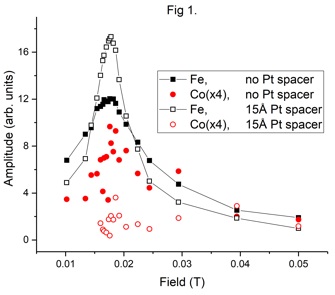
De-coupling of an exchange coupled CoPt/Py bilayer exchange spring with canted magnetic anisotropy using a Pt spacer
A. Frisk, M. Dabrowski, D.M. Burn, D. Newman, R.J. Hicken and G. van der Laan
JEMS Uppsala, Sweeden Aug 2019
Structures with canted magnetic moments are important for the delivery of reduced critical current densities and turn-on time within spin-torque oscillators [1-3]. Such a structure can be realised with an exchange spring. These are usually engineered with anisotropies such that the moments of both hard and soft layers are aligned in the same direction, either in-plane (IP) or out-of-plane (OoP). If instead the hard and soft layers have different anisotropy directions (IP and OoP) then the exchange coupling creates a canted magnetic state at remanence. Using x-ray magnetic circular dichroism (XMCD) and x-ray ferromagnetic resonance (XFMR) at the Co and Fe L2,3 edges [4], at both the Advanced Light Source in the US and the Diamond Light Source in the UK, we have studied the effect of inserting a Pt spacer layer on the exchange coupling within [Co/Pt]/(Pt)/Py (tri-)bi-layer exchange springs with canted magnetic moments (Py = Fe20Ni80).
Samples of Pt(300)/[Co(2)/Pt(9)]10/Pt(x)/Py(y)/Pt(30) (thickness in Å) were grown on Al2O3 (11-20) substrates, using DC magnetron sputtering, with x = 0 and 15 Å and y = 550 and 100 Å. By making the Py layer (y = 550 Å) thick compared to the 110 Å [Co/Pt] layer, the Co moments are canted from the OoP direction. Element resolved hysteresis loops, measured by XMCD, show that the IP shape anisotropy of the Py dominates and pulls the Co moments from their preferred OoP direction towards the IP direction. Using the thinner Py layer, the Py at the interface is instead canted towards the OoP direction, while the Py magnetization relaxes towards the in-plane direction away from the interface. By inserting a Pt spacer layer, the exchange coupling was decreased, resulting in Co moments that were less strongly canted. For samples with the thickness in this study a static exchange coupling was always observed. The canting of the moments is in agreement with work by Hsu and Saravanan et al. [1, 5].
The dynamic exchange coupling between the layers was investigated using XFMR which gives the element resolved FMR. XFMR measurements performed with an IP bias field confirmed that the [Co/Pt] and Py layers are strongly coupled in the samples without the Pt spacer. For a 4GHz RF field, both Co and Fe exhibit a resonance field of 20mT, while in the sample with a Pt spacer only the Fe exhibits a resonance for an IP bias field. See Fig 1 for IP field scans of the resonance amplitude measured by XFMR at the Fe and Co L2,3 edges for a 4GHz RF-field. Vector network analyser FMR (VNA-FMR) was also performed with biasing field IP and OoP. VNA-FMR with IP biasing field was in agreement with the XFMR, while for OoP there was a complex behaviour.

- J.-H. Hsu, et al., JAP, 117, 17A715, (2015)
- I. N. Krivorotov, et al., Science, 307, 228, (2005)
- J.Z. Sun, PRB, 62, 570, (2000)
- G. van der Laan and A. I. Figueroa, Cord. Chem. Rev. 277-278, 95-129, (2014)
- P. Saravanan, et al., JAP, 115, 243905, (2014)